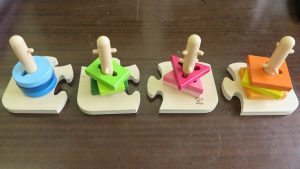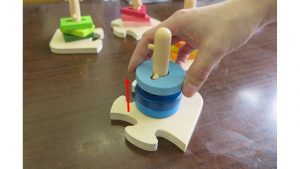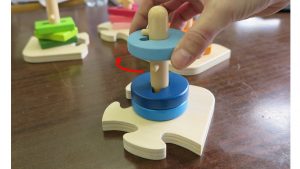
MOTORIC TREE is a game of stacking differently shaped grooved pieces on pegged posts. The objective of the game can be to stack the pieces on the posts or try to take them off the posts. This challenging game promotes coordination, fine motor skills, problem solving skills and logic. It is also useful for training visual perception and recognition. Enjoy the game individually or with your friends and family! Do not forget to challenge your imagination.
Basic information
Definition:
Motoric tree is a game of stacking differently shaped grooved pieces on pegged posts. The objective of the game can be to stack the pieces on the posts, try to take them off the posts or guide the pieces to the other side of the post (like in the version of the game “motoric branch”). The game promotes hand-eye coordination, fine motor skills and problem solving skills.
Objectives
The objective of the game is to take the pieces off the pegged post (motoric tree) or to guide the pieces to the other side of the post (motoric branch).
This game can be very good to improve the following cognitive dimensions:
- Praxis (hand-eye coordination, fine motor skills)
- Problem solving skills
- Visual perception, color and pattern recognition
- Logic
Duration
Duration depends mostly on the player’s abilities (motoric function, motoric speed, hand-eye coordination etc.) and motivation. Usually, solving one motoric tree takes up to 10 minutes.
Cost:
- Physical version: from 15€
References:
- Instructions:
- Background material: download this pdf:
Development
Participants
Participants’ profile:
- Dementia level: mild to moderate dementia levels.
- Physical requirements:
- The player must have good dexterity of arms and fingers and hand-eye coordination.
- The ability to recognize different colors and shapes.
Number of participants: individually
Material and requirements
Materials needed to develop the game:
- In general:
- A table or other similar horizontal surface
- A chair or other comfortable surface to sit on
- Wooden or plastic pegs
- Wooden or plastic grooved pieces of different shapes and colors
Environment considerations:
- Good lighting, low noise levels
Support needed
Professionals / relatives can:
- Explain the game instructions and their variants.
- Supervise the correct playing of the game.
- Guide the player by clues or hints on how to find the correct piece and how to place it on/ off a peg or guide the piece to the other side of the peg.
- Motivating players to finish the task.
- In cases of limited hand and finger movement, the assistant can help the player by guiding their hand.
Starting point:
Put the materials on the table in front of the player. All of the pieces should be placed on top of one another on the pegged post.
Development:
A professional/ relative instructs the player to try and put the top piece off the pegged post. Help the player with instruction on how to rotate the piece and guide it off the post. When the player successfully takes the top piece off the post, a professional/ relative encourages them to continue with the rest of the pieces. When the player successfully puts all of the pieces off the post, a professional/relative can suggest to them to try and put all of the pieces back on.
A professional/relative can increase the difficulty of the game by using posts with more pegs. The game can also be made more difficult by trying to color coordinate the pieces on an individual post.
Instructions on how to play motoric tree can be found at:
Additional information
Variants of the game:
- Pegs can be placed vertically (motoric tree) or horizontally (motoric branch)
- The difficulty of the game depends on the number and combinations of pegs on the post.
- The difficulty can be adapted by adding rules (arranging the pieces on the post by color or shape)
- The game can be played with larger or smaller pieces, depending on the dexterity of player’s hands and fingers.
Alternative games:
Similar games:
- Motoric branch
- Motoric beads
- Peg puzzles
- Geometric sorter
Do it yourself options:
The materials needed for the motoric tree game can be made from wood or plastic. Provide a post with several pegs, pointing in different directions (number of pegs and combinations are optional). Provide 3-5 grooved pieces of different shapes (circles, triangles, squares etc.). The grooves on the pieces should correspond to the combination of the pegs on the post, so the player will be able to take them off the post by rotating them. The post and the pieces can also be colored in different colors.
Assessment:
- The most difficult version of the game that the player succeeds at
- Time needed to finish
- Help and guidance needed to finish
Notes / observations
- The game is not available in ICT format
Practical activity
Arrange the materials on the table in front of the player. All of the pieces should be placed on the pegged posts as shown on the image below.
 Take the first post with the blue pieces and put it in front of the player. The player tries to put the top piece off the pegged post by rotating the piece.
Take the first post with the blue pieces and put it in front of the player. The player tries to put the top piece off the pegged post by rotating the piece.
When the player gets the top piece off the post, he tries to get the other pieces off following the same procedure. When he manages to get all of the pieces off the post, the player tries to put them back on the post. The order of the pieces should be the same as in the starting position.
Continue with the other posts with green, pink and yellow pieces, following the same procedure. The game is finished when all of the pieces are arranged back in the starting position.
![]()





